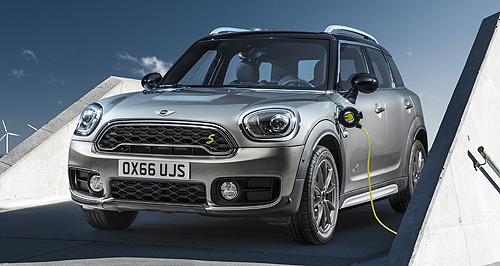Mini Countryman PHEV firming for an Australian launch
BY JUSTIN HILLIARD | 16th Feb 2018

Speaking to journalists at the BMW i3s national media launch in Warrandyte, Victoria this week, Mini Australia product planning manager Daniel Silverwood revealed the company's strategy towards bringing the model to market.
“We’re taking a fairly cautious and measured approach to introduction in Australia. We’ve got a couple of cars here,” he said.
“We’re beginning to talk with customer groups who will potentially be the customer for this car.
“Over the next couple of months we will be taking those cars out and meeting potential customers, with a view to making a decision hopefully sooner, but we’re around about quarter three in the year.
“Basically (a decision) by the end of the year or early in the new year depending on how that goes.”Specifically, Mini Australia has also been gauging interest from the Mini dealer network, councils and government bodies which have all reacted positively to the Countryman PHEV.
Given the model’s low- to mid-30km pure-electric driving range, a typical buyer is projected to live up to 15km from their workplace, meaning they can achieve zero-emissions motoring during their daily commute.
Mr Silverwood added that if Mini Australia gives the green light to the Countryman PHEV, examples imported will feature its upcoming MY19 specifications.
“In terms of timing, if we’re to go down the path of bringing in customer cars, they too will adopt the full level of connectivity – including our e-services – that allow you to check things on your app such as charging status and locations of charging places,” he said.
While full local specifications are still being determined as Mini Australia speaks with customer groups about their expectations, the PHEV will sit between the Cooper SD All4 and JCW All4 in the Countryman range. Pricing-wise, this suggests a cost between $53,300 and $58,900 before on-road costs.
According to Mr Silverwood, Mini Australia's persistence with building a business case for the Countryman PHEV was due to its alignment with the company’s green principles.
“The reason for it … is the direction we’re heading in terms of electrification,” he said. “We’re building up that level of experience as well as contributing to reducing emissions.
“Our brand is founded on minimising footprint and creative uses of space as well being innovative. And we’ve got a very urban customer group (which is) progressively minded.
“We also have, as a part of the BMW Group, that commitment, that expertise, that pioneering spirit to roll out (BMW) i and iPerformance, and with that technology and learnings we’re certainly well positioned as part of our corporate group.
“We also see that there’s a broader market trend of crossovers and SUVs surpassing passenger (cars). We haven’t yet seen that crossover yet with the electric hybrid area, but that's largely due to the availability of products at this stage – for SUV that’s starting to emerge.
“As well, broader changes in society with a stronger focus on CO2 emissions, and in some countries that is more prevalent than in others, but certainly with all those factors combined the plug-in hybrid, certainly as a concept, makes a lot of sense for Mini.”Since its reveal at the Los Angeles motor in November 2016, the Countryman PHEV has been subject to protracted internal discussions but an Australian launch has been progressively firming.
Pairing a 100kW/220Nm 1.5-litre turbo-petrol three-cylinder engine with a 65kW/165Nm electric motor, the Countryman PHEV has combined outputs of 165kW and 385Nm.
Petrol power is sent to the front wheels via a six-speed automatic transmission while electric power is directed to the rear axle, helping to provide all-wheel-drive traction.
Sprinting from zero to 100km/h in 6.8 seconds, the PHEV is only 0.3s slower than its JCW sibling which is 105kg lighter.
Claimed fuel consumption on the combined cycle test ranges from 2.1 to 2.3 litres per 100km, while carbon dioxide emissions have been tested at 49 grams per km.
Its 7.6kWh lithium-ion battery pack takes two hours and 30 minutes to fully charge when using a 3.6kW charger, or three hours and 15 minutes if a standard domestic power outlet is plugged into.
Countryman sales surged last year following the launch of the second-generation model in March, with 797 examples sold to the end of 2017, representing a 50.4 per cent increase over the 530 deliveries made in 2016.
However, the Mini placed fifth in last year's over-$40,000 small-SUV segment, trailing the BMW X1 (3658 units), Mercedes-Benz GLA (3321), Audi Q3 (2843) and Audi Q2 (1999).